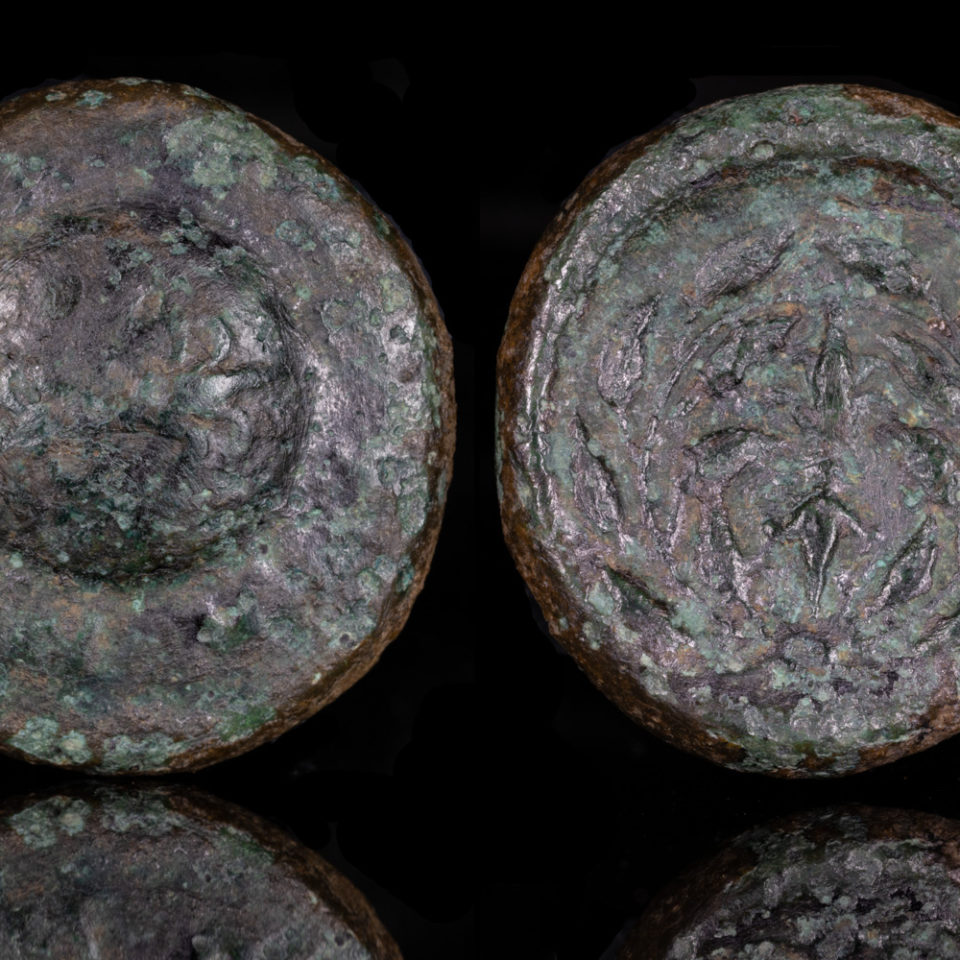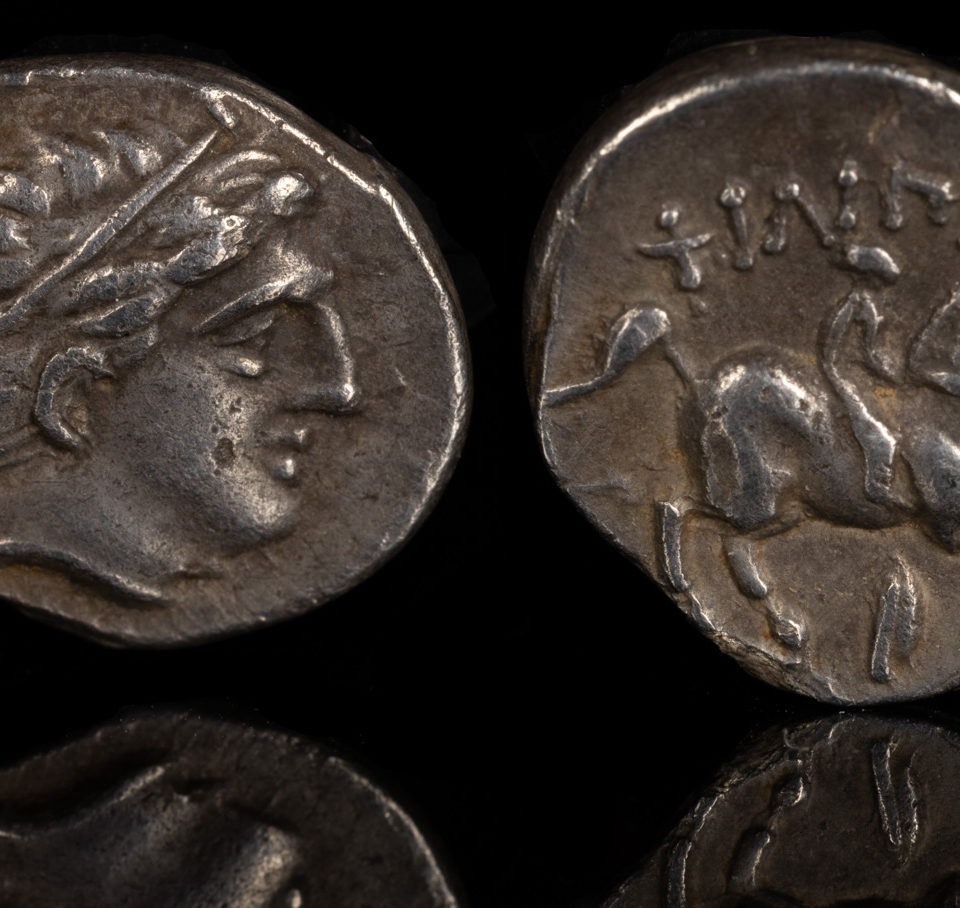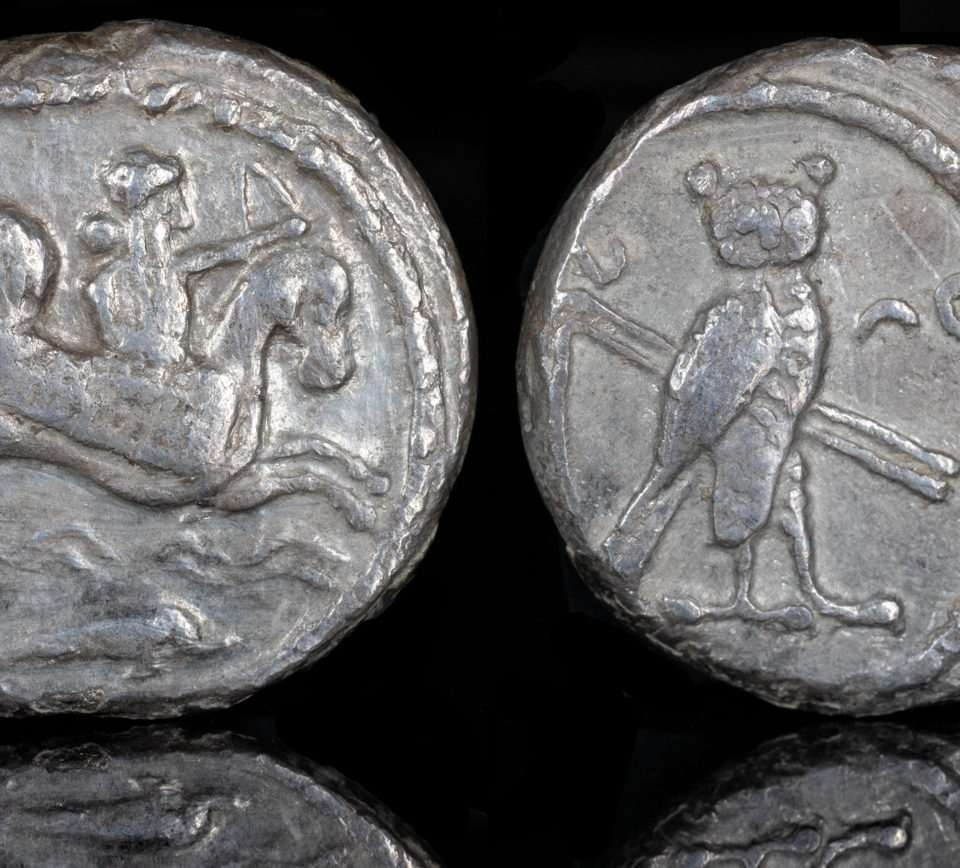A long, long time ago (roughly 2300 years) in a kingdom far, far away (Bithynia in modern day Turkey), lived a king named Nikomedes I. He is pictured on this coin, and had a problem.

circa 280-250 BCE
AE Bronze, 23 mm, 8.75 g, 6 h
Diademed head of Nikomedes I to right.
Rev. BAΣIΛE – NIKOMH Horse prancing right; above, wreath; below foreleg, spearhead.
RG 7. SNG von Aulock 242
His issue was with his brother Zipoetes II. You see, for some reason Zipoetes felt that Nikomedes had bad intentions. This hurt Nikomedes‘ feelings, as just because he killed their other two brothers, didn’t necessarily mean he’d do the same to Zipoetes.
Family gatherings were tense, and when a holiday party resulted in Zipoetes taking a good portion of Bithynia, Nikomedes was at a loss on what to do. Then, one night while he was watching TV, an ad appeared.
“Do you have an insurrection in your kingdom? Is your capital under siege? Do you have the means to transport tens of thousands over the Bosphorus? Then we’re you’re answer. We’re the Gauls.”
Back then, the Gauls were a marauding group of people renowned for their copy arts. You wanted copy-handbags, imitation silphium, or knock-off Tyre purple, the Gauls were your source. They even copied coinage, such as this type, originally minted by Philip II, resumed under Kassander, and copied by the Gauls.

13.16g
Nikomedes couldn’t call the number fast enough, and soon his brother was running for his life from the masses of Gauls. Zipoetes II was executed, and Nikomedes repaid the Gauls by transporting them over the Bosphorus, and he lived happily ever after.
Yet while Bithynia was now in peace, neighboring Macedonia was in chaos. The Gauls had most rudely interrupted their festivals and eaten all the food. Something must be done, and the someone to do it was Ptolemy Keraunos.

AR Tetradrachm
In the name and types of Alexander III. Amphipolis mint. Head of Herakles right, wearing lion skin headdress / Zeus Aëtophoros seated left; monograms in left field and below throne.
Price 537; Mathisen, Administrative –.
Now, among the most illustrious rulers in history, Ptolemy Keraunos is pretty far down the stack. He grew up in Egypt and was the son of the well-regarded Ptolemy I. However, when Ptolemy grew to realize what a rotten son-of-a-bitch Keraunos was, he gave the throne to Keraunos‘ stepbrother, Ptolemy II, who promptly booted Keraunos when he took power.
Ptolemy Keraunos then went on a tour of Eastern Europe, during which time he pissed off pretty much every country. He started with Lysimachos, formerly a bodyguard of Alexander III. As a guest in Lysimachos‘ house, he convinced his host to kill his son Agathokles, which was very unpopular in the kingdom.

Kopf des vergöttlichten Alexander / Athena mit Nike-Statuette auf Cippus und Schild, Beiz. Monogramm und 2 gegenläufige Pferdeprotomen.
Thompson in Festschr. Robinson (1968), -, vgl. 256 HGC 1750q; Thompson, Armenak-Hoard (=ANS MN 31, 198 – Müller, Lysimachus – Arnold-Biucchi in Festschr. Price (1998) Unpublished variant(?)
Aware that he was no longer Lysimachos‘ friend, Ptolemy Keraunos pleaded with the powerful Seleukos I Nikator, who – being a nice guy – stormed the Hellespont and killed Lysimachos. Grateful for the help in time of need, Ptolemy Keraunos offered to join Seleukos in prayer, then stabbed him in the back (literally).
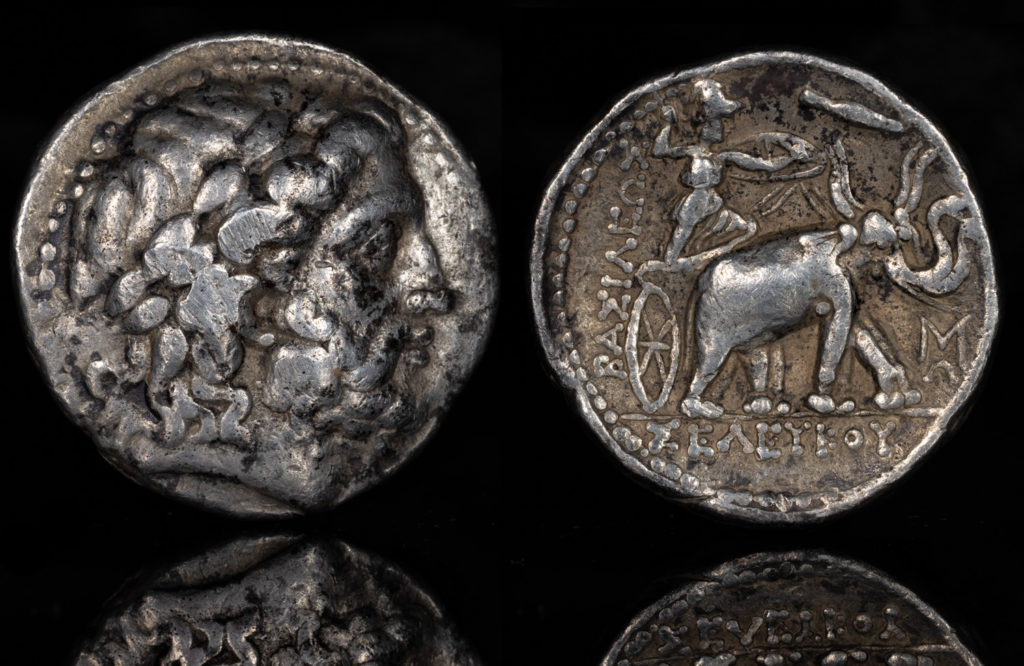
Struck under Archon, Dokimos, or Seleukos I.
Babylon, circa 323-317 BC.
Head of Herakles to right, wearing lion skin headdress / Zeus Aëtophoros seated to left, holding sceptre; BAΣIΛEΩΣ below, AΛEΞANΔPOY to right, M in left field, ΛY below throne. Price 3692; Müller 1272; Hersh 244. 17.18g, 25mm, 12h.
graffito to rev.
Ptolemy Keraunos was now persona-non-grata pretty much everywhere, but he upped the stakes by marrying his half-sister Arsinoe II, then murdering her two youngest children on their wedding day. Arsinoe, who felt this an inappropriate wedding present, fled.
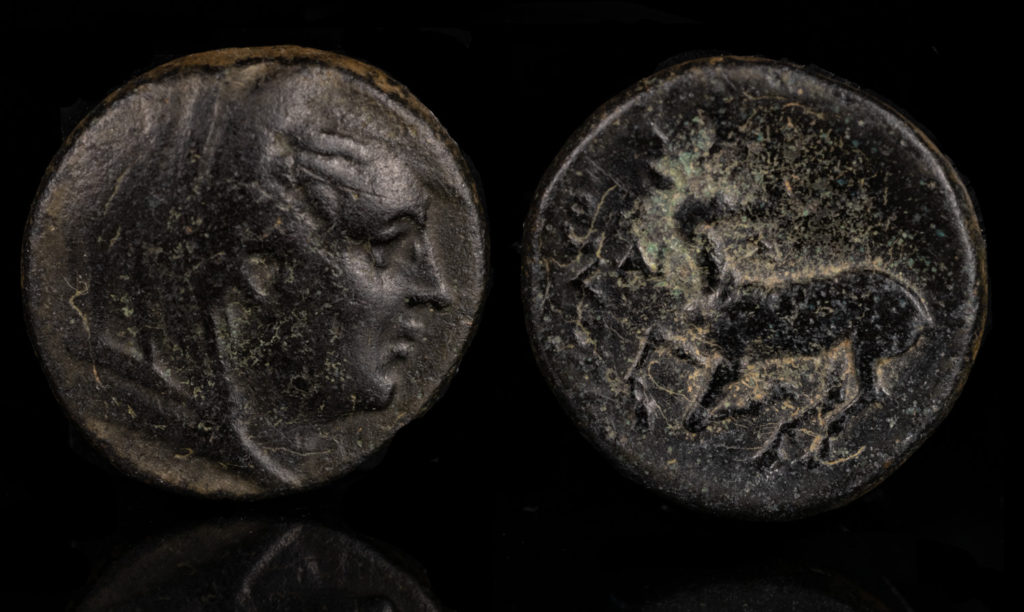
AE Dichalkon 287-281 BCE under Aristagoras
4.23g
Vs.: verschleierter Kopf der Arsinoe II. n. r.
Rs.: Hirsch lagert n. l., Kopf n. r.”
SNG v. Aulock 1840; Svoronos 134, 883 Taf. 26, 13
At the time our Gauls crossed over into Macedonia, the very same Ptolemy Keraunos was its leader. Thrilled at the prospect of pissing off some new people, he hurried to the battlefront without waiting for the proper reinforcements. There, the Gauls defeated him and placed his head on a spear to parade around. The world was not saddened by this.
Yet, as bad as Ptolemy Keraunos was, things took a turn for the worse in Macedonia. There were Gauls everywhere. One couldn’t walk in the street without witnessing this horde pillaging. The Gauls cut in line at the supermarkets, ravaged the countryside, and had horrible manners. The coin below was minted during this time, and though its issue predated and postdated the invasion of the Gauls, it signifies perfectly the feeling of the times.

Macedonian mint 288-277 BCE
3.95 g Sear 6781
Something needed to be done, and when the Gauls attacked the holy city of Delphi, the Greeks had had enough. This time, it was the Aetolians who stepped to the front. The Aetolian League was an exclusive club of cities in ancient Greece, who had lately made some rather poor decisions in arguing with Alexander the Great. But with him out of the picture, they were now the big boys in town. They were also the inventors of the thermos, named for their capital.
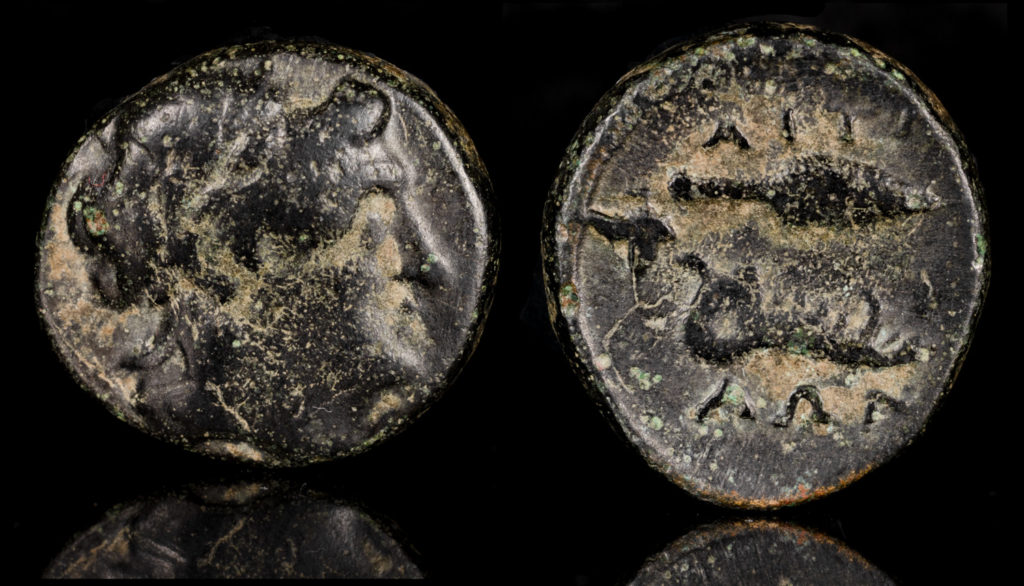
Ae 19mm 6.4g
Obv. Laureate head of Apollo right
Reverse: Spearhead above jawbone of Calydonian boar, grape bunch to left
The Aetolian League teamed up with Antigonos II Gonatas. Antigonos was the rock star of the day, since he enjoyed tremendous fame through both sides of his family. His father was Demetrios I Poliorketes, which means “besieger of cities.” Every time Athens or Rhodes invited Demetrios to dinner, there would be a huge flotilla of triremes outside the city, and all the inhabitants would say “not again, Demetrios!” Demetrios‘ father was Antigonos I Monophthalmos, the famous general of Alexander the Great who finally perished on the battlefield against the combined might of Seleukos, Lysimachos, and Ptolemy at the age of 81.

Tetradrachm AR 30 mm, 17,12 g
Diademed and horned head of young Demetrios right / ΒΑΣΙΛΕΩΣ ΔΗΜΗΤΡΙΟΥ, poseidon standing left resting foot on rock, monograms at either side.
Newell 90
Antigonos‘ mother was Phila, a highly-respected woman who was the daughter of a lowly respected man in Kassander, who himself was son of Alexander III‘s regent in Macedonia, Antipater.
All of this fame was great for Antigonos II Gonatas, but he lacked much of an army to retake his birthright of Macedonia, so he joined with the more powerful Aetolians. Together, they strode out to take on the fierce Gauls.
In an amazing bit of fortune, the work turned out to be easier than thought. While everyone was encamped at night, anxious to fight the next day, an earthquake hit during a lightning storm. The resulting chaos caused the Gauls to panic, and they started killing each other while the Aetolians and Antigonos II Gonatas watched the whole spectacle with popcorn. The next day, they mopped up what remained.
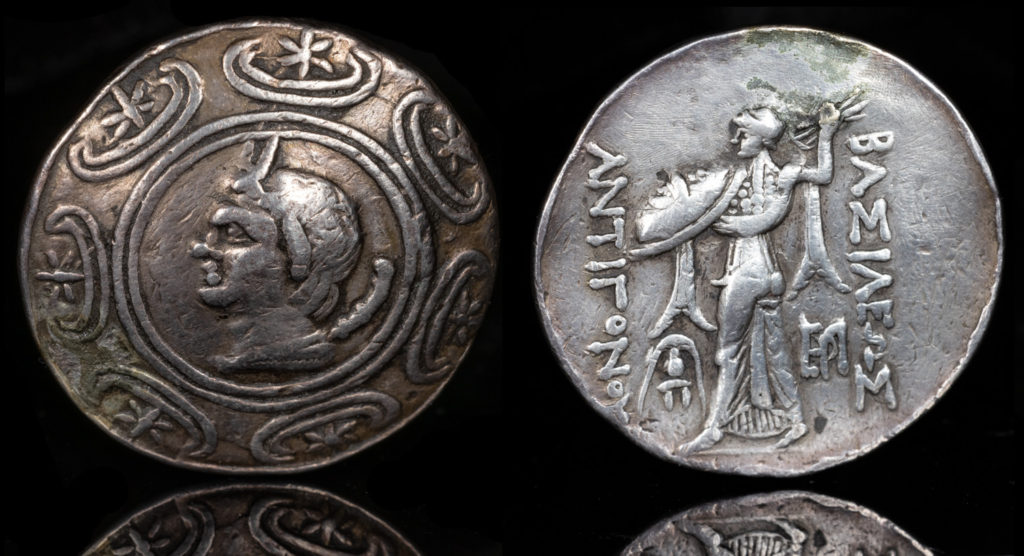
AR Tetradrachm (31mm, 16.85g, 3h)
Amphipolis, c. 274/1-260/55.
Horned head of Pan l., lagobolon over shoulder, in the centre of a Macedonian shield. R/ Athena Alkidemos advancing l., preparing to cast thunderbolt; crested Macedonian helmet to inner l., monogram to inner r. HGC 3, 1042.
Now, although Antigonos wasn’t the best military leader, being the product of royalty had enabled him to achieve his MBA (Macedonian Business Administration), and one skill he learned there was brand marketing. To build his brand, he advertised the whole ordeal by taking Pan – the Deity of Mischief – as his emblem and placing it in the center of all his coins. The Aetolians, who supplied the majority of troops, are still relatively unknown to this day. The Gauls eventually moved to France and became the center of modern day haute couture.


